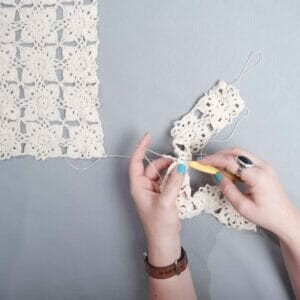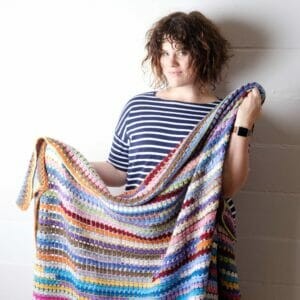Is It Easy To Learn How To Crochet? Absolutely! This comprehensive guide from LEARNS.EDU.VN breaks down the art of crochet into manageable steps, making it accessible for beginners and offering valuable insights for experienced crafters. Discover how to begin your crochet journey, avoid common pitfalls, and unlock a world of creative possibilities with this fulfilling hobby. Let’s explore yarn selection, basic stitches, and terminology for crafting success.
Table of Contents
- Understanding Dye Lots: The Secret to Uniform Crochet Projects
- Embracing the “Frog”: Why Undoing Work Is Part of Crocheting
- Finding Your Unique Crochet Style: Hook and Yarn Holding Techniques
- Selecting the Right Yarn: A Beginner’s Guide to Crochet Success
- Mastering the Chain Stitch: The Foundation of Crochet
- Overcoming Initial Awkwardness: Patience and Practice in Crochet
- Experimenting with Crochet Hooks: Finding the Perfect Fit
- Essential Crochet Stitches: Building Blocks for Complex Patterns
- Navigating US and UK Crochet Terminology: A Helpful Conversion Guide
- Take the Plunge: Start Crocheting Today with LEARNS.EDU.VN
- Frequently Asked Questions (FAQs) About Learning to Crochet
1. Understanding Dye Lots: The Secret to Uniform Crochet Projects
When embarking on your crochet adventure, one of the first hurdles is navigating the world of yarn. The terms like DK, aran, wool blend, and lace weight can seem like a foreign language. Yarn store owners are often fountains of knowledge, but sometimes struggle to explain the absolute basics to newcomers. A crucial concept to grasp early on is the significance of dye lots.
The dye lot is a number that identifies the specific batch in which your yarn was dyed. This might seem insignificant, but if you’re working on a project that requires multiple balls of yarn, using yarn from different dye lots can lead to noticeable variations in color. Imagine using four balls from dye lot 334 and one from dye lot 345 – the subtle difference might not be apparent in the balls themselves, but once crocheted, it can create an unsightly “shadow” or color shift in your work.
For beginners, who often invest considerable time and effort into their projects, having to undo work due to mismatched dye lots can be incredibly disheartening. To avoid this pitfall, always check the dye lots when purchasing yarn and ensure that all balls match. This simple step can save you a lot of frustration and ensure a more professional-looking finished product.
According to the Craft Yarn Council, dye lots are essential for maintaining color consistency in larger projects. Variations can occur due to slight differences in the dyeing process, water temperature, or humidity levels.
2. Embracing the “Frog”: Why Undoing Work Is Part of Crocheting
A common experience among new crocheters is the dismay of having to undo their work, often referred to as “frogging” (because you “rip it, rip it” out). After painstakingly crocheting a few rows, sometimes taking hours, discovering a mistake can feel devastating. The thought of unraveling all that effort is enough to bring tears to some.
However, it’s crucial to accept that frogging is an inevitable part of the crochet process, regardless of skill level. Even experienced crocheters make mistakes, change their minds about a design, or want to try a different technique, all of which require undoing work. It’s a learning opportunity and a chance to refine your skills.
As you progress, you’ll likely find ways to minimize mistakes, but the occasional frogging will always be there. Embrace it as part of the creative process, and don’t let it discourage you from continuing your crochet journey.
“Undoing is not failing; it is feedback,” says Clara Parkes, author of The Knitter’s Book of Knowledge. She emphasizes that mistakes are valuable learning experiences that contribute to skill development.
3. Finding Your Unique Crochet Style: Hook and Yarn Holding Techniques
One of the fascinating aspects of crochet is the diversity of techniques people use to hold their hook and tension their yarn. The internet has made it possible to observe and learn from crocheters around the world, revealing a wide range of styles.
If you happen to see someone crocheting in a way that’s completely different from your own, don’t feel pressured to change. The best way to hold your hook and yarn is the one that feels most comfortable and allows you to create consistent stitches. Stick with what works for you, even if it looks a little unconventional.
However, if you’re struggling to find your rhythm, exploring different techniques can be helpful. Observe how other crocheters hold their hooks and tension their yarn, and experiment with different approaches until you find a style that suits you. Remember, there’s no single “right” way to crochet – it’s about finding what works best for you.
4. Selecting the Right Yarn: A Beginner’s Guide to Crochet Success
Choosing the right yarn is crucial for a positive learning experience. As a beginner, it’s best to avoid dark-colored or very fine yarns, as these can make it difficult to see the stitch definition. Instead, opt for a light-colored cotton yarn in a medium weight, such as DK or 8 ply.
Cotton yarn is ideal for beginners because it maintains its structural integrity when crocheted, making it easier to see the individual stitches. This allows you to clearly observe how the stitches are formed and identify any mistakes. Avoid yarns that are too fuzzy or textured, as these can obscure the stitch definition and make it harder to learn.
According to Vogue Knitting: The Ultimate Knitting Book, cotton yarn is known for its durability, breathability, and ease of care, making it a versatile choice for a wide range of crochet projects. Its smooth texture and clear stitch definition make it especially suitable for beginners.
5. Mastering the Chain Stitch: The Foundation of Crochet
While it might be tempting to jump straight into more complex stitches or patterns, the best place to begin learning how to crochet is with the chain stitch. Dedicate a solid 20 minutes to simply practicing the chain stitch, focusing on developing a consistent tension and getting a feel for the yarn and hook.
The chain stitch forms the foundation for many crochet projects and is essential for understanding the basic mechanics of crocheting. By mastering the chain stitch first, you’ll develop the muscle memory and coordination needed to execute more complex stitches with ease.
6. Overcoming Initial Awkwardness: Patience and Practice in Crochet
Learning to crochet can feel awkward at first, much like learning to ride a bike or drive a car. It takes time and practice to develop the necessary coordination and muscle memory. Don’t get discouraged if you don’t feel like a natural right away – it’s perfectly normal to feel clumsy and unsure in the beginning.
The key to overcoming this initial awkwardness is patience and persistence. Don’t give up after just a few minutes of practice. Instead, commit to practicing for at least 20 minutes each time you pick up a hook. With consistent practice, you’ll gradually develop the skills and confidence you need to create beautiful crochet projects.
“Practice isn’t the thing you do once you’re good. It’s the thing you do that makes you good,” says Malcolm Gladwell, author of Outliers: The Story of Success. This sentiment applies perfectly to learning crochet – consistent practice is the key to mastery.
7. Experimenting with Crochet Hooks: Finding the Perfect Fit
If you’re struggling to get the hang of crocheting, it might be worth experimenting with different types of crochet hooks. There are two main styles of crochet hooks: Bates and Boye. Bates hooks have a more tapered head, while Boye hooks have a rounder, more inline head.
The best type of hook for you depends on your personal preference and crocheting style. Some crocheters find that Bates hooks glide more easily through the yarn, while others prefer the feel of Boye hooks. If possible, try both styles to see which one feels more comfortable and allows you to crochet more smoothly.
Swapping hook styles can sometimes make a significant difference in your crocheting experience. If you’re finding that your yarn is constantly snagging or that you’re having trouble inserting the hook properly, try switching to a different style of hook. You might be surprised at how much of a difference it makes.
8. Essential Crochet Stitches: Building Blocks for Complex Patterns
Once you’ve mastered the chain stitch, the next step is to learn the four basic crochet stitches: single crochet, half double crochet, double crochet, and treble crochet. These four stitches are the foundation for most other crochet stitches and patterns.
By mastering these basic stitches, you’ll unlock a world of creative possibilities. You’ll be able to create a wide variety of textures, patterns, and designs. As you gain experience, you can explore more complex stitches and techniques, but always remember that the four basic stitches are the foundation upon which everything else is built.
According to Crochet for Dummies, mastering the basic crochet stitches is essential for building a solid foundation in crochet. Once you have a good understanding of these stitches, you can confidently tackle more complex patterns and techniques.
9. Navigating US and UK Crochet Terminology: A Helpful Conversion Guide
One of the potential pitfalls for new crocheters is the difference between US and UK crochet terminology. The same stitch can have different names in the two systems, which can lead to confusion when following patterns.
For example, what is called a “single crochet” in the US is known as a “double crochet” in the UK. Similarly, a “double crochet” in the US is called a “treble crochet” in the UK. It’s important to be aware of these differences and to always check which terminology a pattern is using before you start crocheting.
Most good patterns will clearly state whether they are using US or UK terms. However, if you’re unsure, here’s a helpful tip: if the pattern includes a “single crochet” instruction, it’s using US terms, as there is no single crochet stitch in UK terminology.
Here’s a quick conversion table to help you navigate the differences:
| US | UK |
|---|---|
| Single Crochet | Double Crochet |
| Half Double Crochet | Half Treble Crochet |
| Double Crochet | Treble Crochet |
| Treble Crochet | Double Treble Crochet |






10. Take the Plunge: Start Crocheting Today with LEARNS.EDU.VN
The best way to learn how to crochet is to simply jump in and give it a try. Don’t be afraid to make mistakes – they’re a natural part of the learning process. With patience, practice, and the right resources, you’ll be crocheting beautiful creations in no time.
LEARNS.EDU.VN offers a wealth of resources to help you on your crochet journey. Explore our detailed tutorials, beginner-friendly patterns, and expert advice to build your skills and confidence. Join our vibrant online community to connect with fellow crocheters, share your creations, and get support and encouragement along the way.
LEARNS.EDU.VN provides a structured learning environment with video instructions and a supportive community, making it easier than ever to master this rewarding craft. Discover your creative potential and experience the joy of crochet with LEARNS.EDU.VN!
Ready to start your crochet adventure? Visit LEARNS.EDU.VN today and unlock a world of creative possibilities!
11. Frequently Asked Questions (FAQs) About Learning to Crochet
1. Is crochet harder than knitting?
Crochet and knitting both have their challenges, but many beginners find crochet easier to learn due to the use of a single hook and simpler stitch structures.
2. How long does it take to learn the basics of crochet?
With consistent practice, you can learn the basic stitches in a few hours or days. Mastering more complex techniques takes time and experience.
3. What supplies do I need to start crocheting?
You’ll need a crochet hook, yarn, scissors, and a yarn needle for weaving in ends.
4. What is the best yarn for beginners?
Light-colored, medium-weight cotton yarn is ideal for beginners because it’s easy to see the stitches and work with.
5. Where can I find free crochet patterns?
LEARNS.EDU.VN offers a variety of free crochet patterns for beginners. You can also find free patterns on websites like Ravelry and LoveCrafts.
6. How do I read a crochet pattern?
Crochet patterns use abbreviations and symbols to represent different stitches and techniques. LEARNS.EDU.VN provides resources to help you understand these notations.
7. What is gauge in crochet?
Gauge refers to the number of stitches and rows per inch or centimeter. It’s important to match the gauge specified in a pattern to ensure that your finished project will be the correct size.
8. How do I fix mistakes in crochet?
The easiest way to fix most mistakes is to “frog” (undo) your work back to the point where the mistake occurred and then redo the stitches correctly.
9. How can I improve my crochet tension?
Consistent practice is the key to improving your crochet tension. Try to maintain a relaxed grip on the hook and yarn, and avoid pulling the yarn too tightly.
10. Can I teach myself to crochet?
Yes, absolutely! With the abundance of online resources, tutorials, and patterns available, it's easier than ever to teach yourself to crochet. LEARNS.EDU.VN offers a comprehensive learning platform to guide you every step of the way.For more detailed information and expert guidance on learning to crochet, visit LEARNS.EDU.VN. Our comprehensive resources and supportive community will help you master this rewarding craft!
Contact us:
- Address: 123 Education Way, Learnville, CA 90210, United States
- WhatsApp: +1 555-555-1212
- Website: learns.edu.vn